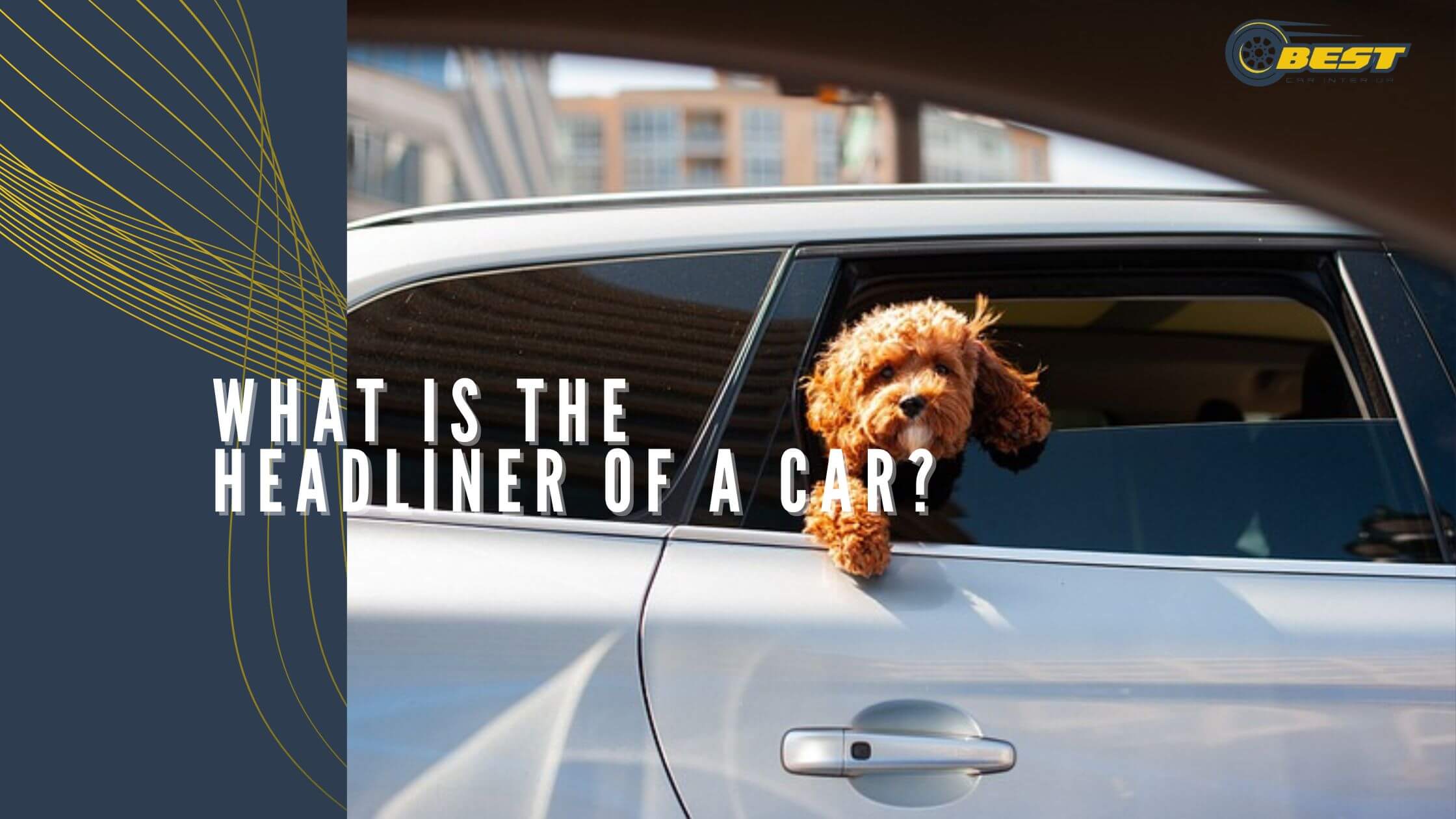The headliner car—the multi-layered fabric that lines the interior roof—contributes to more than just the aesthetics of your vehicle. It plays a critical role in improving cabin comfort by regulating temperature, reducing noise, and concealing electrical components like antennas and sensors. However, over time, headliners may wear out, sag, or peel, requiring repair or replacement. Whether you are dealing with minor fixes or planning a full replacement, understanding the construction and purpose of a headliner car will help you make informed choices, ensuring your car’s interior stays sleek, functional, and comfortable for years to come.
Contents
What is the headliner car?
The headliner is a multi-layered material that lines the interior roof of a car. It plays a crucial role not just in aesthetics but also in the overall comfort, acoustics, and functionality of the vehicle’s cabin.
Purpose and Functionality
- Temperature Regulation:
- The headliner acts as an insulator, helping the vehicle maintain a comfortable interior temperature.
- It keeps the cabin cooler during hot summer days and warmer during winter by reducing heat transfer through the car’s roof.
- Noise Reduction:
- A properly installed headliner dampens wind and road noise, especially when driving at highway speeds.
- The foam or polyurethane layer absorbs sound, improving the acoustics within the cabin. This is particularly noticeable in premium vehicles, which aim for a quieter ride.
- Concealment of Electrical Components:
- The headliner hides important wiring, antennas, sensors, and other hardware installed on the roof, contributing to a sleek and seamless interior design.
Composition and Layers of a Car Headliner
A typical car headliner consists of the following layers:
- Outer Fabric Layer:
- The visible layer, usually made from polyester due to its lightweight, moisture resistance, and affordability. Polyester headliners are common because they are easy to clean with a damp cloth and available in various colors.
- However, polyester can sometimes feel cheap and is more commonly used in economy vehicles.
- Foam or Polyurethane Layer:
- This layer provides softness to the headliner and enhances the cabin’s soundproofing by absorbing external noise.
- The foam layer also ensures the fabric adheres smoothly to the headliner board without sagging or creasing.
- Headliner Board:
- A structural base to which the foam and fabric layers are attached. It ensures the headliner maintains its shape and stays firmly attached to the roof.
Headliner Material Options
Headliners come in a variety of materials, each catering to different tastes and vehicle types:
- Automotive Polyester Fabric:
- Lightweight, affordable, and durable; widely used in standard vehicles. It resists moisture but can wear out over time, particularly when exposed to heat and sunlight.
- Alcantara (Luxury Option):
- A high-end, synthetic suede-like material often used in premium vehicles. Known for being soft to the touch, stain-resistant, and long-lasting.
- Leather, Vinyl, and Suede (Aftermarket Options):
- These materials offer a customized appearance and are often installed by enthusiasts or in luxury vehicles. They add elegance but can be harder to maintain compared to polyester.
- Velvet:
- Though primarily associated with clothing, velvet is used in some headliners for its ability to create either a tufted or smooth look. It provides a unique texture but may require more care to keep clean.
Lifespan of a Car Headliner
- Expected Durability:
- A typical headliner lasts at least 10 years under normal conditions. However, exposure to extreme heat and sunlight can degrade the adhesive and foam layers, causing the fabric to sag or peel from the edges.
- Signs of Wear:
- When the foam backing deteriorates, the headliner can droop, develop creases, or even separate from the headliner board. In such cases, simply reattaching the fabric may not suffice, as the underlying foam needs to be replaced.
How much do headliners usually cost?
The cost of replacing a car’s headliner can vary significantly based on the vehicle type, material selection, and labor fees. Below is a detailed breakdown of the costs, factors that influence the total expense, and where to get the job done properly.
Cost Breakdown of Headliner Replacement
- Standard Vehicles (e.g., Subaru, Kia):
- For common, non-luxury vehicles, replacing the headliner typically costs $500 to $1,000.
- This price includes both labor and materials, with labor often being the larger component of the total bill.
- Luxury Vehicles (e.g., BMW, Audi):
- Headliner replacement costs for high-end cars can be substantially higher, especially if premium materials such as suede, Alcantara, leather, or microfiber are used.
- In these cases, the cost may exceed $1,000 due to the increased difficulty of the job and the higher price of specialty materials.
- Some luxury brands use proprietary materials, which further raises the cost of sourcing and installation.
Factors That Influence the Cost
- Vehicle Make and Model:
- Larger or more complex vehicles (e.g., SUVs and luxury sedans) may take more time to remove and reinstall the headliner, increasing labor costs.
- Luxury models tend to have more intricate interior designs that require extra care and expertise during installation.
- Choice of Materials:
- Foam-backed polyester is the most affordable and common material, typically used in standard vehicles. It is durable, easy to clean, and keeps costs on the lower end.
- Premium materials like leather, vinyl, Alcantara, or suede increase the overall cost significantly due to higher material prices and the additional skill required for installation.
- Custom fabrics or personalized prints may also be available through specialized shops but will add to the expense.
- Labor Fees:
- Labor fees vary depending on the region and the experience of the professional. Specialized upholstery shops tend to charge more but offer better craftsmanship.
- Installation complexity, such as dealing with wiring, sunroofs, or roof-mounted equipment, can increase labor time and cost.
Professional vs. DIY Replacement
- Professional Replacement:
- Professional replacement ensures the headliner is properly aligned and installed without creases or sagging.
- Expect to pay more if you take your vehicle to a reputable automotive upholstery shop. Body shops and detailers also offer headliner replacement services, but specialized upholstery shops with years of experience are often the safest option.
- Total Cost (including labor and materials):
- $500 to $1,000 for standard cars.
- Over $1,000 for luxury vehicles with custom or premium materials.
- DIY Replacement:
- If you choose to replace the headliner yourself, the material costs will range from $50 to $200, depending on the fabric.
- Tools you’ll need include:
- Screwdriver or panel popper (to remove fasteners holding the headliner board).
- Utility knife (for precise fabric cutting).
- Wire brush (to remove any old foam from the board).
- Spray-on adhesive (easier to apply than brush-on glue).
- Budget at least two hours for the job, ensuring you have enough time to carefully remove the old fabric and apply the new material without damaging the headliner board.
Where to Get a Professional Headliner Replacement
- Automotive Upholstery Shops:
- These shops specialize in headliner repairs and replacements and are typically the best option for a high-quality result. Look for long-established businesses with strong reputations in your area.
- Body Shops and Detailers:
- Many body shops and car detailing businesses offer headliner replacement services, though their experience may vary compared to upholstery specialists.
- Recommendations and Online Reviews:
- Ask your local mechanic or body shop for recommendations, as they often have partnerships with reliable upholstery specialists.
- Check online reviews to find the best professionals with verified expertise in headliner replacement.
Conclusion: Headliner Replacement Costs Summary
Replacing a car’s headliner involves several variables, including the type of vehicle, material selection, and labor fees. On average:
- Standard cars: Expect to pay between $500 and $1,000 for a professional replacement.
- Luxury cars or those with premium materials: The cost can exceed $1,000, especially if specialized materials like Alcantara or leather are used.
For those looking to save money, DIY replacement is an option, though it requires the right tools, patience, and attention to detail. Regardless of how it’s done, replacing a worn or sagging headliner can significantly improve the appearance and comfort of your vehicle’s interior.
Is it easy to fix a headliner?
Yes, there are several quick and easy methods to fix a sagging headliner without removing it entirely. Below are the most straightforward techniques:
Easy Methods to Fix a Sagging Headliner
- Using Adhesive Glue (for Partial Sagging):
- Apply a special headliner adhesive spray to reattach the fabric.
- Works well for corners or small areas where the fabric is sagging.
- Regular glue isn’t effective, so it’s crucial to use the correct type of spray adhesive.
- Pinning It Down (Fast and Inexpensive Fix):
- Use sequin pins or other small pins to push the fabric back into the foam backing.
- This method is ideal if half of the headliner is sagging.
- You can arrange pins in a decorative pattern for a visually appealing look.
- Twist Pins (Saggy Stoppers):
- Clear-headed twist pins are easy to use and won’t damage the headliner board.
- This method is effective even if the entire headliner is sagging.
- Twist pins are better than glue or tacks, as they avoid long-term fabric damage.
- Steam Cleaner and Paint Roller Method:
- Use a steam cleaner to melt the existing adhesive, allowing the fabric to reattach.
- After steaming, a paint roller can smooth out the material, ensuring no wrinkles.
- This approach is perfect for sagging along the edges and ensures even application.
Conclusion
Fixing a sagging headliner is relatively easy, especially if the sagging is partial. These simple methods allow car owners to make repairs themselves without needing to remove the headliner, saving time and money. However, using the right tools—like adhesive spray or twist pins—ensures a smooth and durable repair.
Is a headliner hard to replace?
Replacing a headliner is challenging but manageable for those who follow instructions carefully. Here are the key points relevant to the difficulty of replacing a headliner:
- Complex Process but Doable:
- Although it is difficult, anyone can learn how to do it with the right tools and guidance.
- Following a step-by-step process makes it achievable for non-professionals.
- Tools and Preparation:
- You’ll need various tools such as screwdrivers, a bristle brush, adhesive, and a hobby knife.
- The process involves removing accessories like lights, seatbelt covers, and trim panels to access the headliner board.
- Time-Consuming:
- Removing the old fabric, scraping off foam, applying adhesive, and installing the new fabric require careful attention to detail.
- A professional may take 3+ hours, but a DIY effort may take longer, depending on skill level.
- Potential Costs:
- If done yourself, materials can cost $200 to $350.
- Hiring a professional can be more expensive, with labor costs ranging from $75 to $150 per hour.
- Precision Needed:
- The process requires meticulous work, especially when cutting holes for accessories and ensuring a smooth fabric installation.
- Using the wrong adhesive or being careless with installation can result in a poor finish or fabric that doesn’t hold up over time.
In summary, while replacing a headliner is difficult due to the detailed process and time investment, it is not impossible to do yourself with the correct tools, patience, and preparation.

